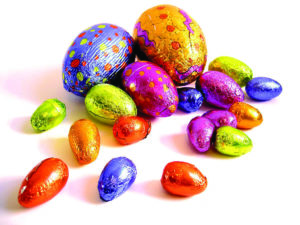Easter commemorates the death and resurrection of Jesus Christ in Jerusalem 2,000 years ago, although the word ‘Easter’ actually has nothing to do with Christianity. Jesus had been crucified on a Friday and rose from the dead on the following Sunday. For Christians, the resurrection of Jesus is a foundation of their faith. The Bible book, Acts, records the words of Peter, one of Jesus’ closest followers and an eyewitnesses to his resurrection. He tells a crowd,  ‘You handed him over to be killed and you disowned him before Pilate…. You killed the author of life but God raised him from the dead. We are witnesses of this.’
‘You handed him over to be killed and you disowned him before Pilate…. You killed the author of life but God raised him from the dead. We are witnesses of this.’
Because the resurrection took place on a Sunday, the first Christians soon adopted Sunday as the day of the week when they gathered to pray together and worship God. But it took much longer for Easter Sunday to emerge as an annual day to celebrate Jesus’ resurrection. And Christians in different countries marked it at different times and in different ways.
Churches use Easter Day to praise God for raising Jesus from the dead and to remember Christian martyrs – believers who had been put to death rather than give up their faith. In some traditions it was also the day on which new converts to Christianity were baptised, usually dressed in white.
The birth date of Jesus is not known. It is commemorated on Christmas Day and in most Christian traditions this is always 25 December. However, Orthodox Christians celebrate it on 7 January because they have a different calendar. Nor was the date of Jesus’ death and resurrection recorded. As a result, Easter is not fixed. It can fall any time between 22 March and 25 April. This is because Easter is linked to the Jewish festival of Passover, which was taking place when Jesus died. The timing of Passover depends on the cycles of the moon. In the 4th century church leaders agreed that Easter would always be on the Sunday following the first full moon after the Spring equinox. But to add to the complexity, they referred to the  mathematically-calculated ‘Paschal’ full moon which is not always the same day as when the moon appears full in the sky!
mathematically-calculated ‘Paschal’ full moon which is not always the same day as when the moon appears full in the sky!
It got even more complicated in the 18th century when the Western and Eastern (Orthodox) Christian churches decided to use different calendars. As a result, Orthodox Christians celebrate Easter on a different Sunday. In recent decades, Church leaders and governments have tried to settle on a specific date for Easter in April but no agreement has been reached.
Easter is the celebration of Jesus’ resurrection and the new life or fresh start that people receive when they become Christians.
How Easter got its name
In most countries, the name for Easter is derived from the word Passover. In French it is Paques; in Spanish, Pascua, and in Italian, Pasqua. The word ‘Easter’ comes from the name for an Anglo-Saxon pagan goddess, Eostre, who was celebrated in Spring. In Germany, the festival is called Ostern because there the goddess is named Ostara. The association of eggs with Easter is very ancient and the origins are not clear. But eggs – and rabbits – are thought to be symbols of new life at springtime and Easter is the celebration of Jesus’ resurrection and the new life or fresh start that people receive when they become Christians.
The History of Easter Eggs
The origin of Easter eggs in history is just as clear. The ancient Druids bore an egg, as the sacred emblem of their order. In the mysteries of Bacchus, as celebrated in Athens, one part of the nocturnal ceremony consisted in the consecration of an egg. The Hindu fables celebrate their mundane egg as of a golden colour. The people of Japan make their sacred egg to have been brazen. In China, dyed or painted eggs are used on sacred festivals. In ancient times, eggs were used in the religious rites of the Egyptians and the Greeks, and were hung up for mystic purposes in their temples.
From Egypt, these sacred eggs can be distinctly traced to the banks of the Euphrates. The classic poets are full of the fable of the mystic egg of the Babylonians. A tale is told by Hyginus, the Egyptian, the learned keeper of the Palatine library at Rome, in the time of Augustus, who was skilled in all the wisdom of his native country, who wrote the following.
“An egg of wondrous size is said to have fallen from heaven into the river Euphrates. The fishes rolled it to the bank, where the doves having settled upon it, and hatched it, out came Venus, who afterwards was called the Syrian Goddess (Astarte)”
The egg became one of the symbols of Astarte or Easter; and accordingly, in Cyprus, one of the chosen seats of the worship of Venus, or Astarte, the egg of wondrous size was represented on a grand scale.
The occult meaning of this mystic egg of Astarte, in one of its aspects, had reference to the ark during the time of the flood, in which the whole human race were shut up, as the chick is enclosed in the egg before it is hatched.
The sacred egg of paganism, as already indicated, is well known as the “mundane egg”, that is, the egg in which the world was shut up. Now the “world” has two distinct meanings. It means either the material earth, or the inhabitants of the earth. The latter meaning of the term is seen in Genesis 11:1, “And the whole earth was of one language and one speech” where the meaning is that the whole people of the world were so.
If then the world is seen shut up in an egg that floats on water, it may not be difficult to believe that the egg thus floating on the wide universal sea might be Noah’s family that contained the whole world in its bosom.
The coming of the egg from heaven evidently refers to the preparation of the ark by express appointment of God; and the same thing seems clearly implied in the Egyptian story of the mundane egg which was said to have come out of the mouth of the great god. The doves resting on the egg need no explanation. This, then, was the meaning of the mystic egg in one aspect.
As, however, everything that was good or beneficial to mankind was represented in the Chaldean mysteries, as in some way connected with the Babylonian goddess, so the greatest blessing to the human race, which the ark contained in its bosom, was held to be Astarte, who was the great civilizer and benefactor of the world.
The deified queen of heaven, whom Astarte represented, had no actual existence until some centuries after the flood. However, through the doctrine of metempsychosis, which was firmly established in Babylon, it was easy for her worshippers to be made to believe that, in a previous incarnation, she had lived in the Antediluvian world, and passed in safety through the waters of the flood. Now the Romish (Catholic) Church adopted this mystic egg of Astarte, and consecrated it as a symbol of Christ’s resurrection.
The real history!
The 1913 Catholic Encyclopedia, in its article on Easter, openly admits that symbols like eggs and rabbits (bunnies represent fertility), used to celebrate the holiday, are NOT based on the Bible! They were “borrowed” from ancient customs pagans used to worship their false deities and adapted by the church for its own purposes.
“The symbolic meaning of a new creation of mankind by Jesus risen from the dead was probably an invention of later times. The custom may have its origin in paganism, for a great many Pagan customs, celebrating the return of spring, gravitated to Easter… “The Easter Rabbit lays the eggs, for which reason they are hidden in a nest or in the garden. The rabbit is a Pagan symbol and has always been an emblem of fertility.”
As Rome cherishes the same feelings as paganism did, so it has adopted the very same symbols, so far as it has the opportunity.
(Source: www.biblestudy.org)



